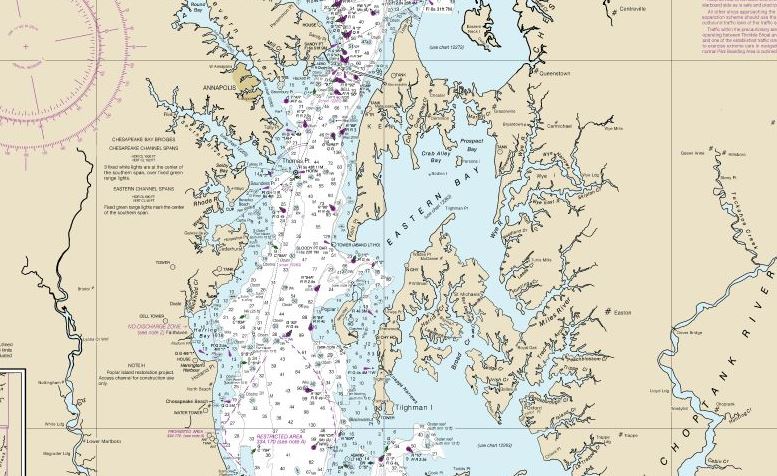Good News for Bay Sailors in the Form of a "C" on Report Card
For the first time since the University of Maryland Center for Environmental Science Chesapeake Bay Report Card scores have been calculated, the positive trajectory that was reported in recent years is now statistically significant. This is important evidence that the positive trend in ecosystem health is real, and that efforts to improve conditions in the Bay are working. The largest estuary in the nation scored a C grade (54%) in the 2017 report card, one of the highest scores calculated. Punctuating this news is the improved A+ (95%) grade for fish populations.
“This is exciting news. It is the first time that the Chesapeake Bay report card scores are significantly trending in the right direction. We have seen individual regions improving before, but not the entire Chesapeake Bay. It seems that the restoration efforts are beginning to take hold,” said Dr. Bill Dennison, Vice President for Science Application at the University of Maryland Center for Environmental Science.
Five of seven indicators improved
Five out of seven indicators of Bay health improved or remained the same in 2017. They are benthic community, aquatic grasses, total nitrogen, chlorophyll a, and dissolved oxygen. In particular, aquatic grasses improved to the highest level ever recorded. This important Bay habitat provides a home for blue crabs and striped bass along with many other species and can be considered a positive beacon and necessary foundation for Bay restoration.
“Underwater grasses are sentinels of change in the shallow waters of Chesapeake Bay,” said Dr. Robert Orth, Professor of Marine Biology at the Virginia Institute of Marine Science. “Not only are we seeing more grasses in areas where they’ve been thriving like the Susquehanna Flats, but we’re actually seeing them appear in areas around Solomons Island and in the York River where they vanished decades ago.”
There were also improvements in seven Bay regions, including the James River which attained an impressive B- for the first time. Other regions that scored better this year are the Elizabeth River, Choptank River, and Upper Western Shore. The region closest to Washington DC, the Potomac River, did not show improvement this year.
Seven of 15 regions improved
Seven out of fifteen regions have significantly improving long-term health trends. Some of the regions are: Patapsco and Back Rivers (including Baltimore), Upper Western Shore, Elizabeth River, and James River. Since 2014, all regions have been improving or remaining steady. No regions are declining over time.
Several other recent studies have shown improvements in Chesapeake Bay conditions. For example, scientists from the University of Maryland Center for Environmental Science showed that dead zones (areas of low or no dissolved oxygen) in the lower Chesapeake Bay are beginning to break up earlier in the year, which is an indication that efforts to reduce nutrient pollution to the Bay are beginning to make an impact. They found that over the past 30 years, the improved oxygen conditions have also created a feedback loop that allows even more nitrogen to be removed from the Bay, which helps ecosystem recovery.
Still progress to be made
This year’s grades are mostly good news; however, there is still progress to be made. Water clarity and chlorophyll a scores in the Bay continue to be low and some regions like the Upper Eastern Shore and the Patuxent River need focused attention to see improvement.
"While we can celebrate progress being made in the restoration of Chesapeake Bay, we can’t take our foot off of the accelerator,” said Dr. Peter Goodwin, President of the University of Maryland Center for Environmental Science. "It is critically important that we continue to invest in science and monitoring to improve management actions which ensure that the Bay continues on its path to recovery."
How we can help
Recommendations for actions to contribute to a cleaner Bay include planting trees and using less fertilizer, which protect the Bay against sediment and nutrient pollution that causes poor water quality.
About the report card
This is the 12th year that the University of Maryland Center for Environmental Science’s Integration and Application Network has produced the report card. It is a comprehensive Bay-wide report card on the health of the entire Chesapeake Bay and is based on easily replicable analysis of data that goes back to 1986. UMCES not only creates a health report, with innovative, science-based metrics, but also outlines plans for involving both the public and private stakeholders. This report card uses extensive data and analysis that enhances and supports the science, management, and restoration of the Bay. For more information about the 2017 Chesapeake Bay Report Card including region-specific data, visit chesapeakebay.ecoreportcard.org.
The University of Maryland Center for Environmental Science leads the way toward better management of Maryland’s natural resources and the protection and restoration of the Chesapeake Bay. From a network of laboratories located across the state, UMCES scientists provide sound evidence and advice to help state and national leaders manage the environment, and prepare future scientists to meet the global challenges of the 21st century.





